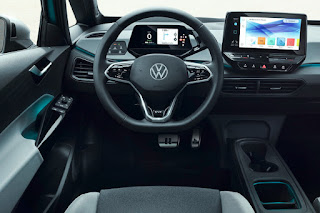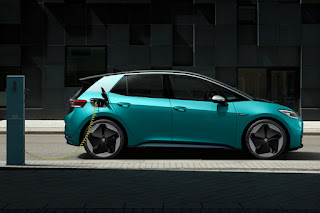Top 10: Facts about the new Volkswagen ID.3
Volkswagen has unveiled its ID.3 at the Frankfurt International Motor Show. Here are ten things to know about this important arrival, which spearheads a family of pure-electric ID vehicles.
1. ID.3 is built on a completely new platform
Rather than modifying the bodyshell from an existing combustion-engine car, Volkswagen has developed a separate ‘modular electric drive matrix’ (or MEB for short). This architecture will underpin every other ID model, too.
2. The interior is spacious
Using MEB yields packaging benefits. For instance, a long wheelbase and short overhangs mean less intrusion into the five-seat passenger compartment.
3. There aren’t many proper switches
Apart from the electric windows and hazard warning lights, everything in the ID.3 is controlled via either dedicated touch-sensitive buttons or the centrally-mounted 10” touchscreen. Whether or not the apparent lack of tactility ends up being distracting remains to be seen, but voice commands can be used instead for most functions if necessary.
4. Initially, one output is being offered
The electric motor sends 201 bhp (150 kW / 204 PS) plus 310 Nm (228 lb/ft) of torque to the rear axle. Although full performance statistics have yet to be released, Volkswagen is quoting a top speed of 99 mph (160 km/h).
5. Customers face a choice of three battery capacities
This is likely to be a major decision, because it affects both practicality and affordability. The options for the underfloor battery pack and their respective WLTP maximum ranges are:
6. Recharging times are somewhat vague
Plugging into a 100 kW fast-charge facility for half an hour adds about 180 miles (290 kilometres) of driving distance. Otherwise, Volkswagen isn’t saying much about this very crucial subject.
7. Pricing promises to be competitive
In Germany, the 45 kWh ID.3 is going to cost less than €30,000. However, for the time being at least, the equivalent UK-market figure is a mystery.
8. A limited edition commemorates the ID.3’s launch
Based on the 58 kWh variant, the special ID.3 1st can be further enhanced with Plus and Max equipment packages. Prices start at under €40,000.
9. Production commences next year
ID.3 deliveries are due to begin in the middle of 2020.
10. The e-Golf continues
Significantly, the ID.3 isn’t really a direct e-Golf rival. Indeed, with 134 bhp (100 kW / 136 PS) and a maximum real-world range of 142 miles (230 kilometres), the latter has very different capabilities.
Related posts:
An electric powertrain for the classic Beetle
Volkswagen I.D. Buzz Cargo concept unveiled
1. ID.3 is built on a completely new platform
Rather than modifying the bodyshell from an existing combustion-engine car, Volkswagen has developed a separate ‘modular electric drive matrix’ (or MEB for short). This architecture will underpin every other ID model, too.
2. The interior is spacious
Using MEB yields packaging benefits. For instance, a long wheelbase and short overhangs mean less intrusion into the five-seat passenger compartment.
3. There aren’t many proper switches
Apart from the electric windows and hazard warning lights, everything in the ID.3 is controlled via either dedicated touch-sensitive buttons or the centrally-mounted 10” touchscreen. Whether or not the apparent lack of tactility ends up being distracting remains to be seen, but voice commands can be used instead for most functions if necessary.
4. Initially, one output is being offered
The electric motor sends 201 bhp (150 kW / 204 PS) plus 310 Nm (228 lb/ft) of torque to the rear axle. Although full performance statistics have yet to be released, Volkswagen is quoting a top speed of 99 mph (160 km/h).
5. Customers face a choice of three battery capacities
This is likely to be a major decision, because it affects both practicality and affordability. The options for the underfloor battery pack and their respective WLTP maximum ranges are:
- 45 kWh / 205 miles (330 kilometres)
- 58 kWh / 260 miles (420 kilometres)
- 77 kWh / 341 miles (550 kilometres)
6. Recharging times are somewhat vague
Plugging into a 100 kW fast-charge facility for half an hour adds about 180 miles (290 kilometres) of driving distance. Otherwise, Volkswagen isn’t saying much about this very crucial subject.
7. Pricing promises to be competitive
In Germany, the 45 kWh ID.3 is going to cost less than €30,000. However, for the time being at least, the equivalent UK-market figure is a mystery.
8. A limited edition commemorates the ID.3’s launch
Based on the 58 kWh variant, the special ID.3 1st can be further enhanced with Plus and Max equipment packages. Prices start at under €40,000.
9. Production commences next year
ID.3 deliveries are due to begin in the middle of 2020.
10. The e-Golf continues
Significantly, the ID.3 isn’t really a direct e-Golf rival. Indeed, with 134 bhp (100 kW / 136 PS) and a maximum real-world range of 142 miles (230 kilometres), the latter has very different capabilities.
Related posts:
An electric powertrain for the classic Beetle
Volkswagen I.D. Buzz Cargo concept unveiled






%2BDashboard.jpg)


+Front+Side.jpg)

+Front+Side.jpg)

Comments
Post a Comment